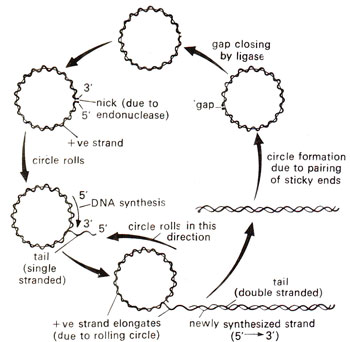Genetics / Chemistry of the Gene / Synthesis, Modification and Repair of DNA
Rolling circle model of DNA replication

Fig. 26.31. Model for replication of circular double helical DNA, based on rolling of DNA circle following a nick formation due to endonuclease.
Alternative mechanism has been suggested for the replication of circular DNA and this is called rolling circle mechanism, which explains multiplication of many viral DNAs and also explains DNA replication during bacterial mating. One of the evidences in support of this model is the observation of long chains of polynucleotides which could measure several times the contour length of circular DNA. In this mode, due to nicking in one of the two strands, one strand becomes a polynucleotide with two ends, one end having 3'-OH group, the other having 5'p group. DNA synthesis starts by adding bases at 3'-OH end, displacing the 5' end, which rolls out as a free tail, and is then copied in 5'→3' direction in small segments using fresh enzymes system. These tails thus become double stranded and give rise to a circular DNA later on. A possible mechanism of replication of circular DNA using rolling circle model is shown in Figure 26.31.

Fig. 26.31. Model for replication of circular double helical DNA, based on rolling of DNA circle following a nick formation due to endonuclease.
Support our developers

More in this section

